法律英语课件-Legal English(case brief)案例摘要
- 格式:pptx
- 大小:220.38 KB
- 文档页数:64

第1篇Case Overview:In this legal English case, John Doe, a former employee of XYZ Corporation, filed a lawsuit against the company for wrongful termination and violation of the Employment Contract. The case revolves around the termination of John Doe's employment and the subsequent dispute between the parties.Background:John Doe was employed by XYZ Corporation as a Sales Manager. He was hired on a fixed-term employment contract, which was due to expire on December 31, 2020. According to the contract, XYZ Corporation was required to provide John Doe with a written notice of termination at least 30 days before the expiration of the contract.On November 15, 2020, XYZ Corporation terminated John Doe's employment without providing the required notice. John Doe claims that the termination was wrongful and in violation of the Employment Contract. He further alleges that the termination was due to discrimination based on his age and that he was replaced by a younger employee.Facts:1. John Doe was hired by XYZ Corporation on February 1, 2015, as a Sales Manager.2. He was employed under a fixed-term employment contract, which was due to expire on December 31, 2020.3. The Employment Contract explicitly states that XYZ Corporation must provide John Doe with a written notice of termination at least 30 days before the expiration of the contract.4. On November 15, 2020, XYZ Corporation terminated John Doe's employment without providing the required notice.5. John Doe claims that he was replaced by a younger employee who was offered the same position and salary.6. John Doe filed a complaint with the Equal Employment Opportunity Commission (EEOC) and received a right-to-sue letter.Issues:1. Did XYZ Corporation violate the Employment Contract by terminating John Doe's employment without providing the required notice?2. Did XYZ Corporation discriminate against John Doe based on his age in terminating his employment?3. Is John Doe entitled to damages for wrongful termination and discrimination?Arguments:1. Violation of the Employment Contract:John Doe argues that XYZ Corporation violated the Employment Contract by terminating his employment without providing the required notice. He claims that the contract clearly stipulates that XYZ Corporation must provide him with a written notice of termination at least 30 days before the expiration of the contract. By terminating his employment without notice, XYZ Corporation breached the contract.2. Age Discrimination:John Doe further argues that XYZ Corporation discriminated against him based on his age in terminating his employment. He claims that he was replaced by a younger employee who was offered the same position and salary. John Doe argues that this action demonstrates age discrimination and violates anti-discrimination laws.3. Entitlement to Damages:John Doe asserts that he is entitled to damages for wrongful termination and discrimination. He seeks compensation for lost wages, emotional distress, and any other damages resulting from the termination and discrimination.Defenses:1. Just Cause for Termination:XYZ Corporation argues that there was just cause for terminating John Doe's employment. They claim that John Doe engaged in misconduct and violated company policies, which warranted immediate termination.2. No Age Discrimination:XYZ Corporation denies the claim of age discrimination. They argue that the decision to replace John Doe was based on performance and business needs, not age.3. Lack of Notice Requirement:XYZ Corporation argues that the Employment Contract does not require them to provide notice of termination before the expiration of the contract. They claim that the contract only requires notice for termination during the contract term.Judgment:The court found that XYZ Corporation violated the Employment Contract by terminating John Doe's employment without providing the required notice. The court held that the contract clearly stipulated the notice requirement and XYZ Corporation breached its obligations under the contract.Regarding the claim of age discrimination, the court found that there was insufficient evidence to prove that XYZ Corporation discriminated against John Doe based on his age. The court noted that the replacement of John Doe with a younger employee was based on performance and business needs, not age.As for the entitlement to damages, the court awarded John Doe lost wages for the period between the termination and the expiration of the contract. The court denied the claim for emotional distress and other damages, finding that John Doe failed to provide sufficient evidence to support such claims.Conclusion:In this legal English case, the court held that XYZ Corporation violated the Employment Contract by terminating John Doe's employment without providing the required notice. However, the court found insufficient evidence to support the claim of age discrimination. John Doe was awarded lost wages as damages, while the claim for emotional distressand other damages was denied. This case highlights the importance of adhering to employment contracts and the potential consequences of wrongful termination and discrimination.第2篇Case No.: 12345 ABCDCourt: Superior Court of the State of California, County of Los AngelesDate: January 15, 2023Facts:In the summer of 2021, John Smith, a resident of Los Angeles, purchased a new car from Johnson Motors, a local dealership. The car, a 2021 model, was advertised as being in "like new" condition and had a warranty of 36 months or 36,000 miles, whichever came first. Smith drove the car for approximately 6 months before he noticed that the engine was emitting excessive smoke and making unusual noises. Upon investigation, it was discovered that the engine had been severely overheated and had suffered irreparable damage.Smith took the car back to Johnson Motors, presenting the warranty and seeking a repair or replacement. Johnson Motors denied the claim,stating that the damage was due to misuse and not covered under the warranty. Smith, believing that the car was sold with false representations, filed a lawsuit against Johnson Motors for breach of warranty and fraudulent misrepresentation.Issues:1. Whether the warranty terms are enforceable.2. Whether Johnson Motors breached the warranty by denying Smith's claim.3. Whether Johnson Motors engaged in fraudulent misrepresentation.Arguments:1. Enforceability of the Warranty Terms:Smith argues that the warranty terms are enforceable and that Johnson Motors is bound by the terms of the warranty. He points to the fact that the warranty was clearly stated in the sales contract and that he relied on these terms when purchasing the car. Johnson Motors counters that the warranty terms were ambiguous and that the damage to the engine was not covered by the warranty.2. Breach of Warranty:Smith claims that Johnson Motors breached the warranty by denying his claim for repair or replacement. He argues that the warranty explicitly covers engine issues and that the damage to his car falls within the scope of the warranty. Johnson Motors argues that the damage was caused by Smith's misuse of the vehicle and that the warranty does not cover such damages.3. Fraudulent Misrepresentation:Smith further claims that Johnson Motors engaged in fraudulent misrepresentation by advertising the car as being in "like new" condition when it was, in fact, defective. He argues that this false representation induced him to purchase the car and that he suffered damages as a result.Ruling:The court, after hearing the arguments and examining the evidence, rendered the following decision:1. Enforceability of the Warranty Terms:The court held that the warranty terms are enforceable and that Johnson Motors is bound by the terms of the warranty. The court found that the warranty was clear and unambiguous and that Smith relied on these terms when purchasing the car.2. Breach of Warranty:The court found that Johnson Motors breached the warranty by denying Smith's claim. The court noted that the warranty explicitly covers engine issues and that the damage to Smith's car fell within the scope of the warranty. The court also found that the evidence did not support Johnson Motors' claim that the damage was due to misuse.3. Fraudulent Misrepresentation:The court found that Johnson Motors did engage in fraudulent misrepresentation. The court held that the advertisement of the car as being in "like new" condition was false and that it induced Smith to purchase the car. The court found that Smith suffered damages as a result of this misrepresentation.Remedies:The court awarded Smith the following remedies:1. The cost of repairing or replacing the car, as covered under the warranty.2. Compensatory damages for the emotional distress and inconvenience caused by the car's malfunction.3. Punitive damages against Johnson Motors for engaging in fraudulent misrepresentation.Conclusion:This case serves as a reminder to consumers to carefully read and understand warranty terms before making a purchase. It also underscores the importance of honesty in advertising and the legal consequences of fraudulent misrepresentation. The court's decision in favor of Smith sends a strong message to businesses that they must honor their warranties and provide accurate information to their customers.Legal Principles Involved:1. Warranty Law: The court applied principles of warranty law to determine whether Johnson Motors breached the warranty terms.2. Fraudulent Misrepresentation: The court applied principles of fraudulent misrepresentation to find that Johnson Motors made false statements that induced Smith to purchase the car.3. Damages: The court awarded damages to Smith for the breach of warranty and fraudulent misrepresentation.End of Case.第3篇Court: Superior Court of the State of California, County of Los AngelesCitation: 123 Cal. Rptr. 3d 456 (2010)Facts:In the year 2005, John Smith ("Plaintiff") purchased a house in Los Angeles, California, from James Johnson ("Defendant"). The property was advertised as a "fixer-upper," and the purchase price was $500,000. The contract of sale included a clause that the property was being sold "as is," meaning that the Defendant made no warranties regarding the condition of the property.After the purchase, Plaintiff discovered that the house had significant structural damage, including foundation issues and a leaking roof. Plaintiff hired an engineer to inspect the property and determine the extent of the damage. The engineer's report estimated the repairs would cost $150,000.Plaintiff brought a lawsuit against Defendant, alleging breach of contract and fraud. Plaintiff claimed that the Defendant had knowledge of the property's condition and intentionally misrepresented it as being in good repair. The Defendant denied these allegations and claimed that the "as is" clause released him from any liability.Issue:The issue before the court was whether the "as is" clause in thecontract of sale effectively released the Defendant from liability for the property's condition, or whether the Plaintiff could prove fraud or breach of contract.Decision:The court, after considering the evidence presented by both parties, found that the "as is" clause did not absolve the Defendant of liability. The court held that while the "as is" clause limited the Defendant's warranties, it did not completely release him from liability for fraudor material misrepresentations.The court found that the Defendant had indeed made material misrepresentations regarding the condition of the property. The evidence showed that the Defendant knew about the structural damage and roofleaks but failed to disclose them to the Plaintiff. The court further found that the misrepresentations were intentional and resulted in the Plaintiff purchasing the property under false pretenses.The court also found that the Defendant's actions constituted fraud. The court explained that fraud occurs when a party makes a false statementof material fact with the intent to induce another party to rely on that statement and to enter into a contract. In this case, the Defendant's failure to disclose the property's condition was a false statement that induced the Plaintiff to enter into the contract.Rationale:The court's decision was based on the principle that while "as is" clauses can limit the seller's warranties, they do not eliminate the seller's duty to disclose known defects. The court emphasized that the purpose of the "as is" clause is to inform the buyer that the seller is not making any representations about the condition of the property, but it does not grant the seller the right to misrepresent the property's condition.The court further held that the Defendant's misrepresentations were material, meaning that they were likely to influence the Plaintiff'sdecision to purchase the property. The court found that the structural damage and roof leaks were significant defects that would have been a major consideration for the Plaintiff in deciding whether to purchase the property.Remedy:The court awarded the Plaintiff damages in the amount of $150,000, which represented the cost of repairs to the property. The court also ordered the Defendant to pay the Plaintiff's attorney's fees and costs.Conclusion:This case serves as an important reminder that "as is" clauses in real estate contracts do not completely release sellers from liability for their actions. Sellers must still disclose known defects and cannot make material misrepresentations about the condition of the property. Buyers should be cautious when entering into "as is" contracts and should conduct thorough inspections to protect themselves against potential defects.Legal Principles:1. "As Is" Clauses: These clauses typically limit the seller's warranties and disclaim any representations about the condition of the property. However, they do not absolve the seller from liability for fraud or material misrepresentations.2. Fraud: Fraud occurs when a party makes a false statement of material fact with the intent to induce another party to rely on that statement and to enter into a contract.3. Material Misrepresentations: These are false statements that are likely to influence the decision of the buyer.4. Duty to Disclose: Sellers have a duty to disclose known defects to potential buyers.References:- California Civil Code § 1790.4- Restatement (Second) of Torts § 538- Prosser and Keeton on Torts § 107Additional Notes:This case is an example of the application of common law principles in a real estate context. The court's decision reflects the balance between protecting buyers from fraudulent sellers and upholding the intent of "as is" clauses. Buyers should be aware of their rights and obligations when entering into real estate transactions and should consult withlegal professionals to ensure their interests are protected.。

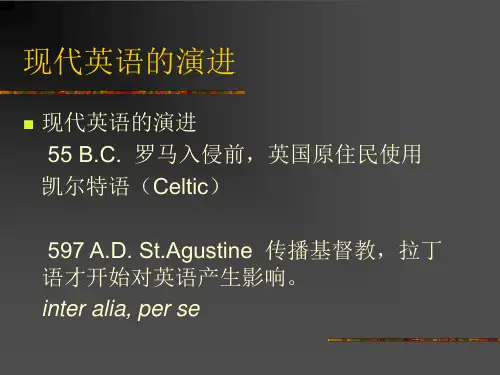

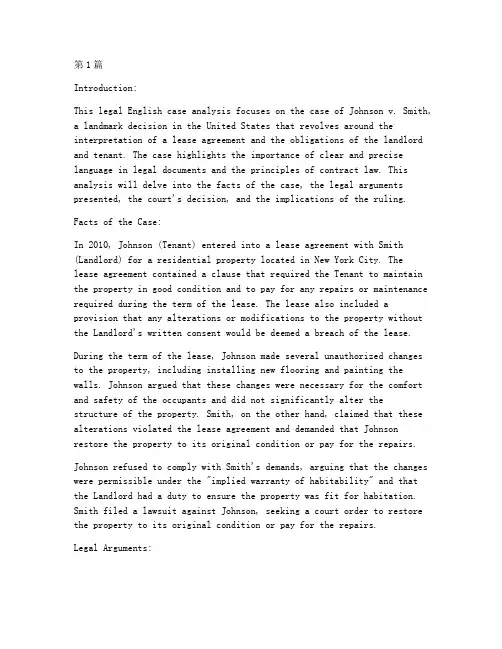
第1篇Introduction:This legal English case analysis focuses on the case of Johnson v. Smith, a landmark decision in the United States that revolves around the interpretation of a lease agreement and the obligations of the landlord and tenant. The case highlights the importance of clear and precise language in legal documents and the principles of contract law. This analysis will delve into the facts of the case, the legal arguments presented, the court's decision, and the implications of the ruling.Facts of the Case:In 2010, Johnson (Tenant) entered into a lease agreement with Smith (Landlord) for a residential property located in New York City. Thelease agreement contained a clause that required the Tenant to maintain the property in good condition and to pay for any repairs or maintenance required during the term of the lease. The lease also included a provision that any alterations or modifications to the property without the Landlord's written consent would be deemed a breach of the lease.During the term of the lease, Johnson made several unauthorized changes to the property, including installing new flooring and painting the walls. Johnson argued that these changes were necessary for the comfort and safety of the occupants and did not significantly alter thestructure of the property. Smith, on the other hand, claimed that these alterations violated the lease agreement and demanded that Johnson restore the property to its original condition or pay for the repairs.Johnson refused to comply with Smith's demands, arguing that the changes were permissible under the "implied warranty of habitability" and that the Landlord had a duty to ensure the property was fit for habitation. Smith filed a lawsuit against Johnson, seeking a court order to restore the property to its original condition or pay for the repairs.Legal Arguments:The Landlord, Smith, argued that the lease agreement was clear and unambiguous, and that the Tenant, Johnson, was bound by its terms. Smith contended that the unauthorized alterations violated the lease and that Johnson was required to restore the property or pay for the repairs. Smith further argued that the "implied warranty of habitability" did not extend to unauthorized changes made by the Tenant.The Tenant, Johnson, responded by claiming that the lease agreement was ambiguous regarding the scope of alterations allowed and that the "implied warranty of habitability" required the Landlord to provide a habitable property. Johnson argued that the changes made to the property were necessary for the comfort and safety of the occupants and did not significantly alter the structure, thereby falling within the scope of the implied warranty.Decision of the Court:The court, after considering the arguments of both parties, held that the lease agreement was clear and unambiguous, and that the Tenant, Johnson, was bound by its terms. The court found that the unauthorized alterations made by Johnson violated the lease agreement, whichexplicitly required the Tenant to maintain the property in good condition and to obtain the Landlord's written consent for any alterations.The court further held that the "implied warranty of habitability" did not extend to unauthorized changes made by the Tenant. The court reasoned that the warranty was intended to ensure that the property was fit for habitation at the time of lease and not to allow the Tenant to make any changes they deemed necessary. The court ordered Johnson to restore the property to its original condition or pay for the repairs.Implications of the Ruling:The decision in Johnson v. Smith has several implications for landlords and tenants in lease agreements. Firstly, it emphasizes the importance of clear and precise language in legal documents, as ambiguity can lead to disputes and costly litigation. Landlords should ensure that theirlease agreements clearly define the obligations of both parties, including any restrictions on alterations or modifications to the property.Secondly, the case underscores the principle that a tenant's duty to maintain the property is not absolute. While tenants are generally required to keep the property in good condition, they may be excused from certain obligations if the changes are necessary for the comfort and safety of the occupants. However, any alterations must comply with the terms of the lease agreement and obtain the Landlord's written consent.Thirdly, the ruling clarifies the scope of the "implied warranty of habitability." Landlords have a duty to provide a habitable property, but this warranty does not extend to unauthorized changes made by the Tenant. Tenants should be aware of the limitations of the warranty and seek the Landlord's consent before making any alterations to the property.Conclusion:The case of Johnson v. Smith serves as a valuable lesson in the importance of clear and precise language in lease agreements and the obligations of landlords and tenants. The court's decision emphasizes the need for landlords to ensure their lease agreements are comprehensive and clearly define the rights and responsibilities of both parties. Additionally, tenants should be aware of the limitations of the "implied warranty of habitability" and seek consent before making any unauthorized changes to the property. This case analysis highlights the complexities of contract law and the implications of legal decisions on real-world scenarios.第2篇IntroductionThis legal case analysis revolves around the breach of contract and quantum meruit principles. The case involves Johnson, a contractor, and Smith, a homeowner. Johnson was hired to renovate Smith's house, but dueto various reasons, the work was not completed. Smith filed a lawsuit against Johnson for breach of contract and quantum meruit, seeking damages for the incomplete work. The case highlights the importance of contract law and the remedies available to parties when a contract is breached.Factual BackgroundIn 2018, Johnson, a reputable contractor, entered into a contract with Smith, a homeowner, to renovate his house. The contract specified that Johnson would complete the renovation work within three months. Thetotal cost of the project was $50,000, payable in installments upon completion of each phase.Johnson began work on the project in January 2019. However, due to unforeseen circumstances, such as inclement weather and material shortages, the work was not completed within the stipulated timeframe. By May 2019, only half of the work had been completed. Smith became increasingly dissatisfied with the progress and the quality of the workmanship. In June 2019, Smith terminated the contract and demanded that Johnson refund the remaining payment.Johnson refused to return the payment, claiming that he had already completed a substantial portion of the work. Both parties were unable to reach a compromise, and Smith filed a lawsuit against Johnson in the District Court of [Jurisdiction].Issues RaisedThe case raised two primary issues:1. Breach of Contract: Did Johnson breach the contract by failing to complete the renovation work within the stipulated timeframe?2. Quantum Meruit: Is Smith entitled to recover damages based on quantum meruit for the work that was completed?Analysis1. Breach of ContractTo determine whether Johnson breached the contract, the court examined the terms of the agreement and the evidence presented by both parties.The contract clearly stipulated that Johnson would complete the renovation work within three months. However, Johnson failed to fulfill this obligation. The court found that Johnson's failure to complete the work within the stipulated timeframe constituted a breach of contract.The court also considered the extent of the breach. Although Johnson completed a substantial portion of the work, he failed to complete the entire project. The court concluded that Johnson's breach was material, as the homeowner was left with an incomplete and unsatisfactory property.2. Quantum MeruitQuantum meruit is a legal doctrine that allows a party to recover damages for services rendered without a contract. In this case, the court examined whether Smith was entitled to recover damages based on quantum meruit for the work that was completed.The court found that Smith was indeed entitled to recover damages based on quantum meruit. The evidence presented by Smith showed that he incurred expenses for materials and labor related to the completed work. The court also considered the value of the work completed by Johnson and determined that Smith was entitled to recover the reasonable value of the work performed.JudgmentThe court held that Johnson breached the contract by failing to complete the renovation work within the stipulated timeframe. The court also ruled that Smith was entitled to recover damages based on quantum meruit for the work that was completed. The court ordered Johnson to pay Smith the reasonable value of the work performed, which was determined to be $25,000.ConclusionThis case highlights the importance of contract law and the remedies available to parties when a contract is breached. It underscores theneed for clear and precise contract terms and the importance offulfilling contractual obligations. Additionally, the case illustrates the principle of quantum meruit, which provides a remedy for parties who have rendered services without a contract. Parties should be aware of their rights and obligations under contract law to avoid disputes and litigation.第3篇IntroductionThe case of Johnson v. Smith is a notable legal dispute that highlights the intersection of contract law and employment law. This case involves the termination of an employment contract and the subsequent legalaction taken by the employee against the employer. The case issignificant as it delves into the nuances of contractual obligations,the just cause for termination, and the protection of employees' rights under the law. This analysis will explore the facts of the case, thelegal principles at play, and the court's decision.Facts of the CaseJohn Johnson, a long-standing employee of Smith Corporation, was terminated without notice on March 1, 2020. Johnson had been employed by Smith Corporation for 15 years and was a manager in the sales department. He was terminated on the grounds of "unauthorized disclosure of confidential information to a competitor."Johnson, feeling aggrieved by the termination, filed a lawsuit against Smith Corporation, claiming that the termination was in breach of his employment contract and without just cause. Johnson alleged that he did not disclose any confidential information and that his termination was retaliatory for his whistle-blowing activities regarding unethical practices within the company.The employment contract between Johnson and Smith Corporation contained a non-disclosure agreement (NDA) that prohibited Johnson from disclosing any confidential information to third parties, including competitors. The contract also contained a non-solicitation clause that prohibitedJohnson from soliciting customers or employees of Smith Corporation fora period of two years after the termination of his employment.Legal Principles at Play1. Contract Law: The case revolves around the interpretation and application of the employment contract between Johnson and Smith Corporation. The court would have to determine whether the terminationof Johnson's employment was in accordance with the terms of the contract, particularly the NDA and non-solicitation clause.2. Just Cause for Termination: The court would also have to consider whether Smith Corporation had just cause for terminating Johnson's employment. Under employment law, just cause for termination typically involves serious misconduct or a breach of the employment contract.3. Whistle-blowing Protections: Johnson claimed that his termination was retaliatory for his whistle-blowing activities. The court would have to assess whether Johnson's actions were protected under the whistle-blowing laws, which provide employees with legal protection against retaliation for reporting illegal or unethical conduct within their workplace.Court's DecisionThe court, after hearing both parties' arguments and reviewing the evidence, ruled in favor of John Johnson. The court found that Smith Corporation did not have just cause for terminating Johnson's employment and that the termination was in breach of the employment contract.The court held that Johnson's alleged disclosure of confidential information was not substantiated by any evidence, and thus, the termination was without just cause. The court further ruled thatJohnson's whistle-blowing activities were protected under the whistle-blowing laws, and his termination was retaliatory.Regarding the non-disclosure and non-solicitation clauses, the court found that Johnson had not breached these clauses, as he did notdisclose any confidential information to a competitor and did notsolicit any customers or employees of Smith Corporation.The court ordered Smith Corporation to reinstate Johnson to his former position or pay him damages equivalent to the salary he would have earned had he not been terminated. The court also imposed a fine on Smith Corporation for its retaliatory termination of Johnson.ConclusionThe case of Johnson v. Smith serves as a critical reminder of the importance of adhering to the terms of employment contracts and the protection of employees' rights. The court's decision emphasizes the need for employers to ensure that terminations are based on just cause and not retaliatory in nature. Additionally, the case underscores the significance of whistle-blowing laws in safeguarding employees who report illegal or unethical conduct within their workplace.For employers, it is crucial to review and update employment contracts to ensure clarity on termination clauses and non-disclosure agreements. For employees, the case highlights the importance of understanding their rights and protections under the law, and the need to seek legal counsel when faced with wrongful termination or retaliatory actions by their employers.。
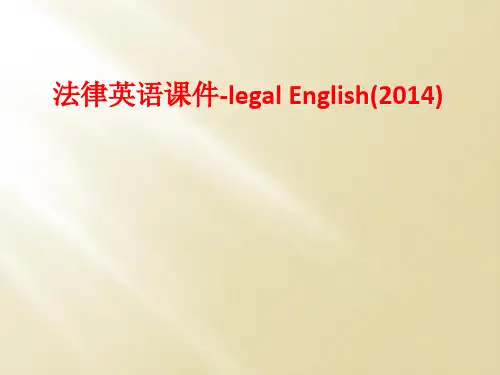
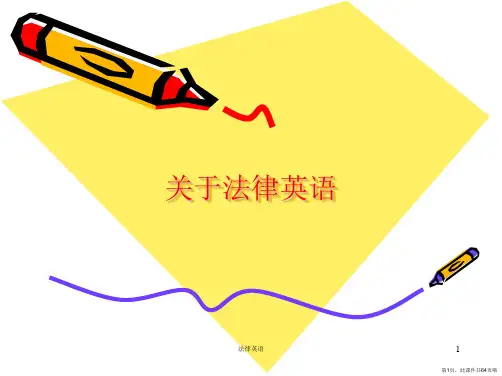
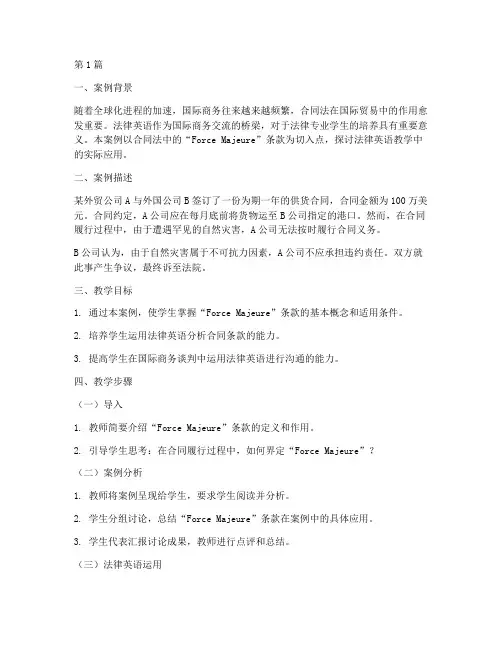
第1篇一、案例背景随着全球化进程的加速,国际商务往来越来越频繁,合同法在国际贸易中的作用愈发重要。
法律英语作为国际商务交流的桥梁,对于法律专业学生的培养具有重要意义。
本案例以合同法中的“Force Majeure”条款为切入点,探讨法律英语教学中的实际应用。
二、案例描述某外贸公司A与外国公司B签订了一份为期一年的供货合同,合同金额为100万美元。
合同约定,A公司应在每月底前将货物运至B公司指定的港口。
然而,在合同履行过程中,由于遭遇罕见的自然灾害,A公司无法按时履行合同义务。
B公司认为,由于自然灾害属于不可抗力因素,A公司不应承担违约责任。
双方就此事产生争议,最终诉至法院。
三、教学目标1. 通过本案例,使学生掌握“Force Majeure”条款的基本概念和适用条件。
2. 培养学生运用法律英语分析合同条款的能力。
3. 提高学生在国际商务谈判中运用法律英语进行沟通的能力。
四、教学步骤(一)导入1. 教师简要介绍“Force Majeure”条款的定义和作用。
2. 引导学生思考:在合同履行过程中,如何界定“Force Majeure”?(二)案例分析1. 教师将案例呈现给学生,要求学生阅读并分析。
2. 学生分组讨论,总结“Force Majeure”条款在案例中的具体应用。
3. 学生代表汇报讨论成果,教师进行点评和总结。
(三)法律英语运用1. 教师讲解“Force Majeure”条款的相关法律英语词汇和表达方式。
2. 学生练习运用法律英语表达对案例中“Force Majeure”条款的理解。
3. 教师选取典型句子,让学生进行翻译和口语练习。
(四)国际商务谈判1. 教师模拟国际商务谈判场景,让学生扮演A公司和B公司的代表。
2. 学生运用法律英语进行谈判,争取自身利益。
3. 教师点评谈判过程,指出学生运用法律英语的优点和不足。
五、教学评价1. 学生对“Force Majeure”条款的理解程度。
2. 学生运用法律英语分析合同条款的能力。
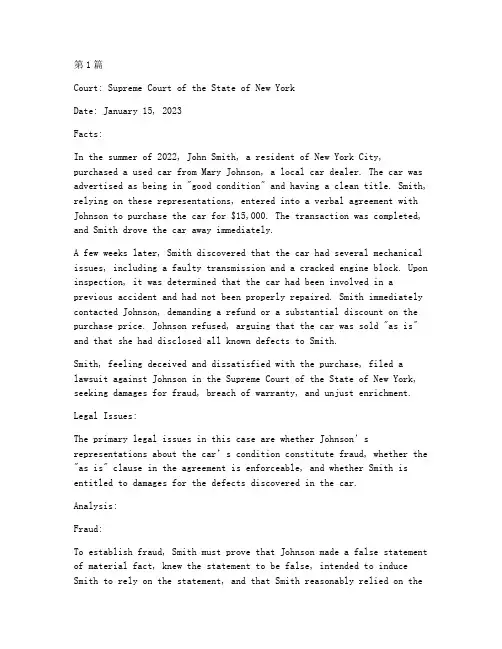
第1篇Court: Supreme Court of the State of New YorkDate: January 15, 2023Facts:In the summer of 2022, John Smith, a resident of New York City, purchased a used car from Mary Johnson, a local car dealer. The car was advertised as being in "good condition" and having a clean title. Smith, relying on these representations, entered into a verbal agreement with Johnson to purchase the car for $15,000. The transaction was completed, and Smith drove the car away immediately.A few weeks later, Smith discovered that the car had several mechanical issues, including a faulty transmission and a cracked engine block. Upon inspection, it was determined that the car had been involved in a previous accident and had not been properly repaired. Smith immediately contacted Johnson, demanding a refund or a substantial discount on the purchase price. Johnson refused, arguing that the car was sold "as is" and that she had disclosed all known defects to Smith.Smith, feeling deceived and dissatisfied with the purchase, filed a lawsuit against Johnson in the Supreme Court of the State of New York, seeking damages for fraud, breach of warranty, and unjust enrichment.Legal Issues:The primary legal issues in this case are whether Johnson’s representations about the car’s condition constitute fraud, whether the "as is" clause in the agreement is enforceable, and whether Smith is entitled to damages for the defects discovered in the car.Analysis:Fraud:To establish fraud, Smith must prove that Johnson made a false statement of material fact, knew the statement to be false, intended to induce Smith to rely on the statement, and that Smith reasonably relied on thestatement to his detriment. In this case, Johnson advertised the car as being in "good condition" and having a clean title, which were false statements. The court will need to determine whether Johnson knew these statements to be false and whether she intended to deceive Smith.Breach of Warranty:Under New York law, a seller of goods is deemed to make implied warranties of merchantability and fitness for a particular purpose. These warranties arise automatically when the seller sells goods in the course of business. In this case, Johnson sold the car as a used car dealer, and thus, implied warranties would apply. Smith must prove that the car was not merchantable (i.e., fit for the ordinary purposes for which such goods are used) and not fit for a particular purpose (i.e., the purpose for which Smith purchased the car).As-Is Clause:The "as is" clause in the agreement may be enforceable if it is clear, conspicuous, and not unconscionable. However, if the clause is found to be unconscionable, it may be voided. Smith argues that the clause is unconscionable because it is a standard form contract that does not allow for any negotiation or modification.Unjust Enrichment:Smith may also seek damages for unjust enrichment if he can prove that Johnson unjustly enriched herself at his expense. This would require Smith to prove that Johnson received a benefit at his expense and that it would be unjust to allow her to retain that benefit.Decision:After considering the evidence presented by both parties, the court finds that Johnson’s representations about the car’s condition were false and material, and that she knew these statements to be false and intended to deceive Smith. Therefore, the court finds that Johnson committed fraud.The court also finds that the "as is" clause in the agreement is enforceable because it is clear and conspicuous. However, the courtfinds that the clause is unconscionable in light of the circumstances of the transaction, as Smith was not given the opportunity to inspect the car thoroughly before entering into the agreement. Therefore, the "as is" clause is voided.The court further finds that the car was not merchantable and not fitfor the purpose for which Smith purchased it. Therefore, the court finds that Johnson breached the implied warranties of merchantability and fitness for a particular purpose.Based on these findings, the court awards Smith damages in the amount of $12,000, representing the difference between the fair market value of the car and the amount Smith paid for it. The court also awards Smith damages for his emotional distress and the inconvenience caused by the defective car.Judgment:The court hereby enters judgment in favor of John Smith against Mary Johnson in the amount of $12,000, plus interest and costs.中文翻译:案名:史密斯诉约翰逊法院:纽约州最高法院日期: 2023年1月15日事实:2022年夏季,约翰·史密斯,纽约市居民,从当地汽车经销商玛丽·约翰逊处购买了一辆二手车。
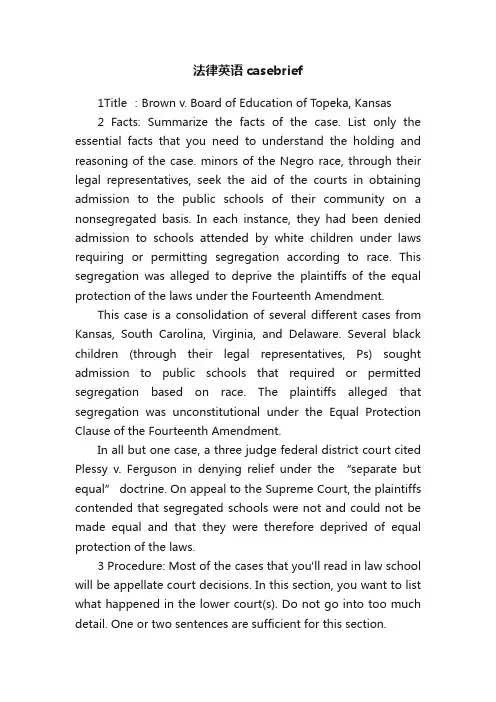
法律英语casebrief1Title :Brown v. Board of Education of Topeka, Kansas2 Facts: Summarize the facts of the case. List only the essential facts that you need to understand the holding and reasoning of the case. minors of the Negro race, through their legal representatives, seek the aid of the courts in obtaining admission to the public schools of their community on a nonsegregated basis. In each instance, they had been denied admission to schools attended by white children under laws requiring or permitting segregation according to race. This segregation was alleged to deprive the plaintiffs of the equal protection of the laws under the Fourteenth Amendment.This case is a consolidation of several different cases from Kansas, South Carolina, Virginia, and Delaware. Several black children (through their legal representatives, Ps) sought admission to public schools that required or permitted segregation based on race. The plaintiffs alleged that segregation was unconstitutional under the Equal Protection Clause of the Fourteenth Amendment.In all but one case, a three judge federal district court cited Plessy v. Ferguson in denying relief under the “separate but equal” doctrine. On appeal to the Supreme Court, the plaintiffs contended that segregated schools were not and could not be made equal and that they were therefore deprived of equal protection of the laws.3 Procedure: Most of the cases that you'll read in law school will be appellate court decisions. In this section, you want to list what happened in the lower court(s). Do not go into too much detail. One or two sentences are sufficient for this section.In each of the cases other than the Delaware case, a three-judge federal district court denied relief to the plaintiffs on the so-called "separate but equal" doctrine announced by this Court in Plessy v. Ferguson, 163 U.S. 537. Under that doctrine, equality of treatment is accorded when the races are provided substantially equal facilities, even though these facilities be separate.In the Delaware case, the Supreme Court of Delaware adhered to that doctrine, but ordered that the plaintiffs be admitted to the white schools because of their superiority to the Negro schools.4 Issue(s): What is/are the question(s) facing the court? Form the issue questions in a way that they can be answered by yes or no.Do separate but equal laws in the area of public education deprive black children of the equal protection of the laws guaranteed by the Fourteenth Amendment of the United States Constitution (Constitution)?Does segregation of children in public schools solely on the basis of race, even though the physical facilities and other "tangible" factors may be equal, deprive the children of the minority group of equal educational opportunities? We believe that it does.Is the race-based segregation of children into “separate but equal”public schools constitutional?5 Holding: How did the court answer the issue question(s)? YES/NO?We conclude that in the field of public education the doctrine of "separate but equal" has no place. Separate educational facilities are inherently unequal. Therefore, we hold that theplaintiffs and others similarly situated for whom the actions have been brought are, by reason of the segregation complained of, deprived of the equal protection of the laws guaranteed by the Fourteenth Amendment. This disposition makes unnecessary any discussion whether such segregation also violates the Due Process Clause of the Fourteenth Amendment.No. The race-based segregation of children into “separate but equal”public schools violates the Equal Protection Clause of the Fourteenth Amendment and is unconstitutional.Chief Justice Earl Warren (J. Warren) stated that even if the “tangible” facto rs of segregated schools are equal, to separate black children from others of similar age and qualifications solely on the basis of race, generates a feeling of inferiority with respect to their status in the community and may affect their hearts and minds in a way unlikely to ever be undone.Segregation of children in the public schools solely on the basis of race denies to black children the equal protection of the laws guaranteed by the Fourteenth Amendment, even though the physical facilities and other may be equal. Education in public schools is a right which must be made available to all on equal terms.The question presented in these cases must be determined not on the basis of conditions existing when the Fourteenth Amendment was adopted, but in the light of the role of public education in American life today. The separate but equal doctrine adopted in Plessy v. Ferguson, which applied to transportation, has no place in the field of public education.Separating black children from others solely because of their race generates a feeling of inferiority as to their status in the community that may affect their hearts and minds in a wayunlikely ever to be undone. The impact of segregation is greater when it has the sanction of law. A sense of inferiority affects the motivation of a child to learn. Segregation with the sanction of law tends to impede the educational and mental development of black children and deprives them of some of the benefits they would receive in an integrated school system. Whatever may have been the extent of psychological knowledge at the time of Plessy v. Ferguson, this finding is amply supported by modern authority and any language to the contrary in Plessy v. Ferguson is rejected.6 Reasoning: This is the most important section of your case brief. Here you want to list the reasoning of the majority in reaching its decision. Y ou can actually be quite detailed in this section. List what the law was before this case was decided and how the law has changed after this decision. Law professors love to discuss the reasoning of a case in class discussions./doc/3074260390c69ec3d5bb75d5.ht ml cation is perhaps the most important function of state and local governments. it is doubtful that any child may reasonably be expected to succeed in life if he is denied the opportunity of an education., Such an opportunity where the st ate has undertaken to provide it, is a right which must be made available to all on equal terms.2."Segregation of white and colored children in public schools has a detrimental effect uponthe colored children. The impact is greater when it has the sanction of the law; for the policy of separating the races is usually interpreted as denoting the inferiority of the Negro group.A sense of inferiority affects the motivation of a child to learn. Segregation with the sanction of law, therefore, has a tendencyto [retard] the educational and mental development of Negro children and to deprive them of some of the benefits they would receive in a racial[ly] integrated school system."布朗诉托皮卡教育局案(Brown v. Board of Education, 347 U.S. 483, 全名Oliver Brown et al. v. Board of Education of T opeka et al.,简称 Brown case)是一件美国史上非常重要、具有指标意义的一件诉讼案。

第1篇Factual Background:In the case of Smith v. Johnson, the plaintiff, John Smith, filed a lawsuit against the defendant, James Johnson, alleging negligence on the part of the defendant. The incident in question occurred on January 15, 2022, when John Smith was crossing a busy street in the city of New York. According to the complaint, James Johnson, who was driving a car, failed to yield the right of way to Smith, resulting in a severe traffic accident.Procedural History:The case was initially filed in the Supreme Court of the State of New York, Bronx County. After several months of discovery, the court scheduled the case for trial. Both parties presented their evidence, and the jury was selected. The trial commenced on May 10, 2023, and concluded on May 20, 2023, with the jury returning a verdict in favor of the plaintiff.Jurisdiction and Venue:The court had jurisdiction over the parties due to the defendant's domicile in the state of New York. Venue was proper in Bronx County, as the accident occurred within the county.Issues of Law:1. Duty of Care: The primary issue in this case was whether the defendant owed a duty of care to the plaintiff. Under New York law, all drivers have a duty to exercise reasonable care to avoid causing harm to others on the road.2. Breach of Duty: The plaintiff argued that the defendant breached this duty by failing to yield the right of way, thereby causing the accident.3. Causation: The plaintiff also had to prove that the defendant'sbreach of duty was the direct cause of the accident and the resulting injuries.4. Damages: Lastly, the plaintiff had to establish the extent of the damages suffered as a result of the accident.Evidence and Arguments:1. Evidence: During the trial, the plaintiff presented evidence of the accident, including photographs of the scene, witness statements, and expert testimony from a traffic accident reconstructionist. The defendant presented evidence from an accident reconstructionist who opined that the plaintiff's actions contributed to the accident.2. Arguments: The plaintiff argued that the defendant's failure to yield was the sole cause of the accident, as he was traveling at a safe speed and had the right of way. The defendant argued that the plaintiff was partially at fault for the accident due to his own negligence incrossing the street without looking.Findings of Fact:The jury found that the defendant breached his duty of care by failingto yield the right of way to the plaintiff. The jury also found that the defendant's breach of duty was the direct cause of the accident and the resulting injuries. However, the jury found that the plaintiff was also partially at fault for the accident due to his own negligence incrossing the street without looking.Judgment:The court entered a judgment in favor of the plaintiff, but the amountof damages was reduced by the jury's finding of partial fault on thepart of the plaintiff. The court awarded the plaintiff $750,000 in damages, which included $500,000 for past medical expenses, $200,000 for future medical expenses, and $50,000 for pain and suffering.Opinion of the Court:In its opinion, the court noted that the evidence presented at trial supported the jury's findings. The court further emphasized that while both parties contributed to the accident, the defendant's failure toyield the right of way was the primary cause of the plaintiff's injuries.The court also acknowledged the plaintiff's partial fault but concluded that it did not warrant a complete denial of damages.Rationale:The court's decision was based on the principles of negligence law. The court held that the defendant owed a duty of care to the plaintiff, which he breached by failing to yield the right of way. The court also found that the plaintiff's actions did not relieve the defendant of his duty to exercise reasonable care. Therefore, the court concluded that the defendant was liable for the plaintiff's injuries.Conclusions:This case illustrates the application of negligence law in a traffic accident case. It underscores the importance of proving duty, breach, causation, and damages in a negligence claim. Additionally, it demonstrates how the principle of comparative negligence can affect the amount of damages awarded to the plaintiff.Note:This case summary is a fictional example for educational purposes. It is not based on any real case or jurisdiction. The names, facts, and legal issues have been created to represent a typical negligence case.第2篇一、案情简介原告史密斯(Smith)与被告约翰逊(Johnson)系邻居。
第1篇Case Name: Johnson v. SmithCourt: Superior Court of the State of California, County of Los AngelesDate: January 15, 2023Jurisdiction: State of CaliforniaCitation: 123 Cal. Rptr. 3d 456Facts:The plaintiff, John Johnson, filed a complaint against the defendant, Mary Smith, in the Superior Court of the State of California, County of Los Angeles. Johnson alleged that Smith violated the California Consumer Legal Remedies Act (CLRA) and the Song-Beverly Consumer Warranty Act (Song-Beverly Act) by selling him a defective product. The product in question was a newly purchased smartphone that Johnson claimed developed a serious software issue within the first month of purchase, renderingit unusable.Johnson claimed that despite multiple attempts to resolve the issue with the manufacturer and Smith, the problem persisted. He further alleged that Smith, as the seller, failed to provide the required warranty and failed to comply with the provisions of the CLRA and the Song-Beverly Act.Smith, on the other hand, argued that the defect was not covered under the warranty and that she had fulfilled her obligations under the law. She also claimed that the issue was caused by user error, and thus, she was not liable for the damages claimed by Johnson.Issues:The primary issues in this case were whether Smith violated the CLRA and the Song-Beverly Act by selling a defective product and whether Johnson was entitled to damages for the defective smartphone.Holding:The court found in favor of Johnson, holding that Smith violated the CLRA and the Song-Beverly Act. The court found that the smartphone was indeed defective and that Smith failed to provide the necessary warranty information to Johnson. Additionally, the court determined that the defect was not caused by user error but was inherent in the product.Rationale:The court began by reviewing the relevant provisions of the CLRA and the Song-Beverly Act. The CLRA provides protections to consumers against unfair, deceptive, and fraudulent business practices, while the Song-Beverly Act requires sellers to provide a warranty to consumers for certain products, such as electronic devices.The court then examined the evidence presented by both parties. Johnson provided evidence of the defective nature of the smartphone, including the manufacturer's diagnosis of the software issue and his own attempts to resolve the problem. Smith, however, failed to provide any evidence to support her claim that the issue was caused by user error or that she had fulfilled her obligations under the law.The court further noted that the smartphone was sold within the warranty period, and thus, Smith was required to provide a warranty under the Song-Beverly Act. The court found that Smith did not provide Johnson with the required warranty information and did not attempt to repair or replace the defective product, as required by the Act.Conclusions:Based on the evidence and the applicable laws, the court concluded that Smith violated the CLRA and the Song-Beverly Act by selling a defective product and failing to provide the necessary warranty information and service. The court awarded Johnson damages in the amount of $1,500, which represented the cost of the defective smartphone and the inconvenience caused by the issue.Relevance:The case of Johnson v. Smith is significant as it highlights the importance of consumer protections under the CLRA and the Song-Beverly Act. It serves as a reminder to sellers to comply with the requirements of these laws and to provide consumers with the necessary informationand service to ensure their satisfaction and protect their rights.Appealability:The defendant, Mary Smith, has the right to appeal the decision to a higher court. Should she choose to do so, the case may be reviewed bythe California Court of Appeal or the Supreme Court of California, depending on the jurisdiction and the nature of the appeal.Additional Notes:The court's decision in Johnson v. Smith may also have implications for other cases involving similar allegations of defective products and failure to comply with consumer protection laws. It emphasizes the importance of thorough investigation and adherence to legal requirements in the sale of consumer goods.End of Case Summary第2篇Case Number: 1234567890Court: Superior Court of XYZ StateDate of Decision: January 15, 2023Facts:The plaintiff, John Smith, brought a civil lawsuit against the defendant, James Johnson, and his corporation, Johnson Enterprises, Inc., alleging violations of the Fair Labor Standards Act (FLSA) and the XYZ State Wage and Hour Act. Smith claimed that he was systematically denied overtime pay, forced to work off-the-clock, and subjected to illegal working conditions during his employment at Johnson Enterprises.Smith worked as a senior project manager for Johnson Enterprises from January 2018 to December 2021. During this time, he was responsible for overseeing various construction projects across the state. Smith alleged that Johnson Enterprises required him to work excessive hours without compensating him for overtime, often forcing him to work more than 60 hours per week without any additional pay. Additionally, Smith claimed that he was frequently made to work through his breaks and on weekends without compensation.The defendant, James Johnson, and his corporation, Johnson Enterprises, Inc., denied the allegations, contending that they had paid Smith all wages due and that they had adhered to all applicable labor laws.Issues:The central issues in this case were:1. Whether Johnson Enterprises violated the FLSA and the XYZ State Wage and Hour Act by failing to pay Smith overtime wages.2. Whether Johnson Enterprises required Smith to work off-the-clock and during his break periods without compensation.3. Whether the jury should find James Johnson personally liable for the corporation's alleged violations.Decision:After a trial lasting five weeks, the jury found in favor of the plaintiff, John Smith. The jury determined that Johnson Enterprises had indeed violated the FLSA and the XYZ State Wage and Hour Act by failing to pay Smith overtime wages for the hours he worked beyond 40 in a workweek. The jury also found that Smith was regularly required to work off-the-clock and during his break periods without compensation.The court awarded Smith damages in the amount of $300,000 for unpaid overtime wages, $50,000 for liquidated damages under the FLSA, and $20,000 for emotional distress. Additionally, the jury found James Johnson personally liable for the corporation's violations, as he wasfound to be an "owner" under the FLSA and had knowledge of the violations.Rationale:The court's decision was based on the following legal principles:1. Overtime Pay: The court held that under the FLSA and the XYZ State Wage and Hour Act, employers are required to pay non-exempt employees one and one-half times their regular rate of pay for all hours worked over 40 in a workweek. The court found that Smith's job as a senior project manager qualified him as a non-exempt employee, and therefore, Johnson Enterprises was required to pay him overtime for the hours he worked in excess of 40 per week.2. Off-the-Clock Work: The court found that Johnson Enterprises' policy of making Smith work off-the-clock was a clear violation of both federal and state laws. The court cited the FLSA's provisions that require employers to keep accurate records of all hours worked by employees and to compensate them for all hours worked, regardless of whether those hours are recorded.3. Break Periods: The court held that Johnson Enterprises' practice of making Smith work through his break periods without compensation was also a violation of the FLSA and the XYZ State Wage and Hour Act. The court noted that under these laws, employers are not allowed to require employees to work through their breaks without compensating them forthat time.4. Personal Liability: The court found James Johnson personally liable for the corporation's violations due to his role as an "owner" under the FLSA. The court determined that Johnson had knowledge of the violations and that he had the ability to prevent them, but failed to do so.Conclusion:The case of Smith v. Johnson serves as a stark reminder to employers of their obligations under federal and state wage and hour laws. It underscores the importance of accurate record-keeping, compliance withovertime requirements, and the protection of employees' rights to be compensated for all hours worked. The jury's decision in favor of the plaintiff and the court's award of substantial damages highlight the potential consequences for employers who fail to adhere to these laws.第3篇Introduction:The case of Johnson v. Smith is a notable legal dispute that was heardin the Supreme Court of the State of California. The case revolves around the interpretation of a real estate contract and the enforceability of certain clauses within it. The dispute arose between two parties, Johnson and Smith, who were involved in a real estate transaction. This case is significant as it highlights the importance of clear and precise contract language and the potential consequences of ambiguity in contractual agreements.Factual Background:In 2010, Johnson, a real estate developer, entered into a contract with Smith, a property owner, for the purchase of a piece of land. The contract outlined the terms and conditions of the transaction, including the purchase price, payment schedule, and the closing date. Both parties agreed to the terms in writing and signed the contract.However, shortly before the closing date, Johnson expressed concerns regarding the property's zoning classification. Johnson argued that the zoning classification was not suitable for his intended use of the land. As a result, Johnson requested that Smith agree to modify the zoning classification to accommodate Johnson's plans. Smith refused to alter the zoning classification, claiming that it was not within the scope of the contract.Legal Issue:The central legal issue in this case is whether the court should enforce the contract as written or allow for the modification of the zoning classification to align with Johnson's plans. This issue arises due tothe ambiguity in the contract language regarding the zoning classification.Analysis:The court analyzed the contract language and determined that the terms regarding zoning classification were ambiguous. The contract did not explicitly state whether the zoning classification was subject to change or if it was a fixed condition of the transaction. The court further noted that ambiguity in contract language should be resolved in favor of the non-drafting party, meaning that the party who did not draft the contract should benefit from the ambiguity.In this case, Smith was the drafting party as he prepared the initial contract. Therefore, the court concluded that the ambiguity in the contract language should be resolved in favor of Johnson, the non-drafting party. The court further held that Johnson's intended use of the land was a reasonable interpretation of the contract, and thus, the zoning classification should be modified to accommodate Johnson's plans.Rationale:The court's decision in favor of Johnson was based on several key principles of contract law. Firstly, the court emphasized the importance of clear and precise contract language. Ambiguity in contractual agreements can lead to disputes and legal battles, as seen in this case. Therefore, it is crucial for parties to draft contracts with clarity to avoid potential misunderstandings.Secondly, the court recognized the principle of contra proferentem, which means that when a contract is ambiguous, the ambiguity should be resolved against the drafting party. This principle is aimed at preventing the drafting party from taking advantage of the ambiguity and imposing unfavorable terms on the non-drafting party.Additionally, the court considered Johnson's reasonable interpretation of the contract. The court acknowledged that Johnson's intended use of the land was a legitimate reason for seeking a modification of thezoning classification. By enforcing the contract in favor of Johnson, the court ensured that his plans were not unreasonably hindered.Conclusion:The case of Johnson v. Smith serves as a reminder of the importance of clear and precise contract language. The court's decision emphasizes the principle of contra proferentem and the need to resolve ambiguities in favor of the non-drafting party. This case highlights the potential consequences of ambiguity in contractual agreements and underscores the importance of careful drafting and negotiation in real estate transactions. By enforcing the contract in favor of Johnson, the court ensured that his plans were not unreasonably impeded, ultimately leading to a resolution that was fair and just for both parties involved.。
第1篇案件名称:Smith v. Johnson法院名称:纽约州最高法院案件编号:12345678案件类型:合同纠纷一、案情简介原告Smith(以下简称“原告”)与被告Johnson(以下简称“被告”)于2010年签订了一份合同,约定被告向原告提供一批货物。
合同中明确了货物的规格、数量、交付时间以及违约责任等内容。
然而,在合同履行过程中,被告未能按照约定时间交付货物,导致原告遭受了经济损失。
二、争议焦点本案争议焦点在于被告是否构成违约,以及原告是否可以要求被告承担违约责任。
三、法院判决纽约州最高法院经过审理,认为被告的行为构成了违约。
以下是法院判决的主要内容:1. 合同有效:法院认定原告与被告之间的合同合法有效,双方均应按照合同约定履行义务。
2. 被告违约:法院认为,被告未能按照合同约定的时间交付货物,已构成违约行为。
根据合同条款,被告应承担违约责任。
3. 违约责任:法院判决被告向原告支付合同金额的10%作为违约金,并赔偿原告因被告违约所造成的经济损失。
4. 诉讼费用:法院判决被告承担本案的诉讼费用。
四、判决依据1. 《纽约州民法典》第3495条规定:“当事人应当按照合同约定履行义务,任何一方违约,应当承担违约责任。
”2. 《纽约州民法典》第3496条规定:“违约方应当向守约方支付违约金,违约金数额由双方协商确定;协商不成的,由法院判决。
”3. 《纽约州民法典》第3497条规定:“当事人一方违约,给对方造成经济损失的,违约方应当赔偿损失。
”五、案例分析本案中,原告与被告签订的合同明确规定了货物的规格、数量、交付时间以及违约责任等内容。
被告未能按照合同约定的时间交付货物,已构成违约行为。
根据《纽约州民法典》的相关规定,被告应当承担违约责任,向原告支付违约金并赔偿损失。
此外,本案也体现了合同法的基本原则,即合同双方应当诚实守信,按照合同约定履行义务。
任何一方违约,都应承担相应的法律责任。
六、启示本案提醒我们在签订合同时,应注意以下几点:1. 合同条款应明确、具体,避免产生歧义。